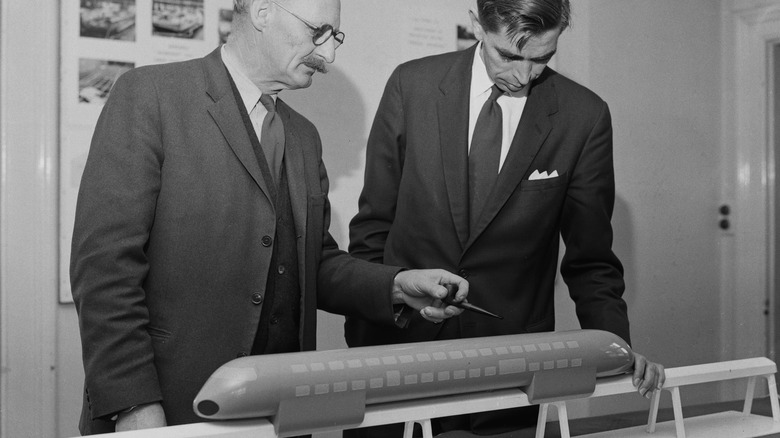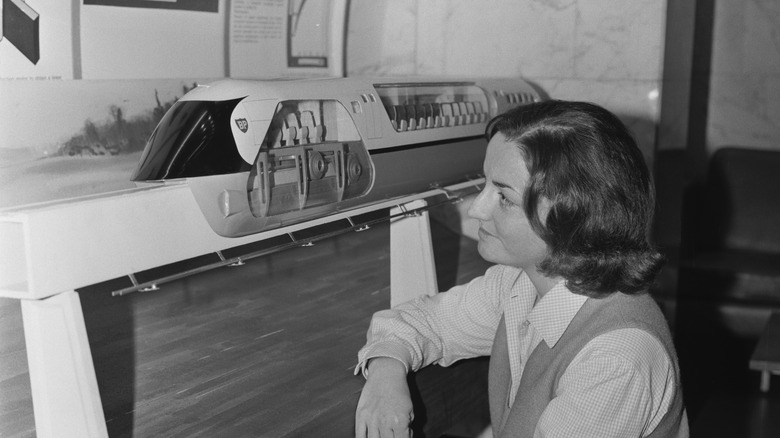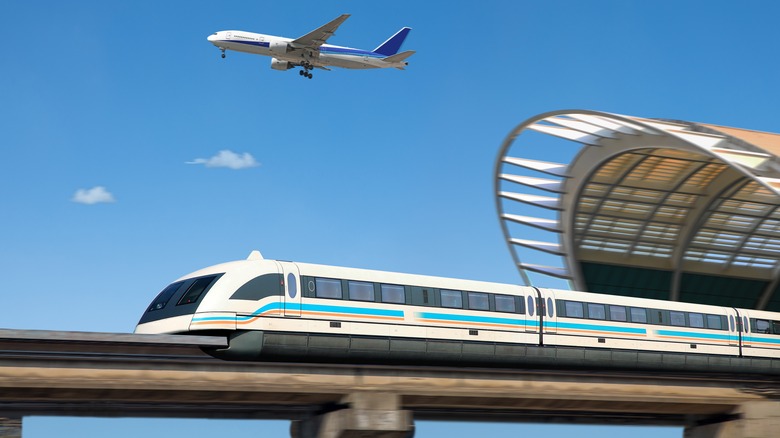The Surprising Reason Why Hovertrains Aren't Everywhere
The hovertrain was a science fiction marvel that made its way into the real world. In the 1970s, manufacturers all over the United States and Europe were particularly interested in making them a staple asset in the transportations systems of America, France, and Britain (via Popular Mechanics).
Shortly after prototype models were built, the plans for adoption on a widespread scale fell by the wayside as a result of many unique shortcomings that these fast movers were plagued by (via Wired). While it's true that a hovertrain could potentially reinvent the way that we think about ground transportation (and manufacturers are often brought back to the model of the hovercar for this very reason), one significant mechanical barrier to the dramatic speed of the vehicles was the inevitable need to slow substantially around turns. Even so, the safety needs and mechanics of travel relating to speed were only one issue.
For starters, advanced passenger movement on the ground simply isn't required over country-spanning distances in many places. While Wired notes that a high speed transportation system of this sort could accomplish a journey from San Francisco to Los Angeles in roughly 35 minutes, the demand for this kind of voyage hasn't made it a priority for city planners and private industry.
This isn't to say that rail lines don't have their place. France has recently committed to a retirement of domestic flights that could be accommodated by a train journey taking less than two and a half hours, according to Railway-Technology.
Hovertrain technology is flawed, but is a springboard for innovation
The hovertrain was a lofty and important step in the right direction, but in practice, the cars are more energy-demanding than initially estimated (via Wired), and in truth, any new rail line would have to be laid with the understanding that the new model would be competing with an existing segment of conventional train access, according to UAS Vision. The economics of these types of building projects are highly complex, but suffice it to say that a newly minted train would certainly cost far more than an established line. Even if the hovertrain could complete a route with high demand in half the time of a competitor, many would likely still opt for the slower train out of financial expedience for years to come.
Another key issue in the rollout of the hovertrain was propulsion. In order to truly hover over a track, the train must be powered by something other than a traditional, and highly mechanically efficient combination of an engine and wheel assembly, this was tackled with linear induction motors, ducted propellers, and other innovations (via Mustard).
Eventually, these designs fell by the wayside. Mustard notes that a combination of technical efficiency — as lower speeds required to turn or pull into a station made hovertrains far less effective than conventional rail transportation — and a global recession led governments around the world to abandon their plans for hovertrain networks.
Maglev trains pick up where hovertrains falter
The hovertrain led to one unique offshoot that can still be seen today, however. The maglev train is essentially a hovertrain concept that uses magnets instead of air currents to lift the vehicle off the track and propel it along its voyage. Mustard notes that maglev trains were already in development while the hovertrain was being tested, and the efficiency of the electromagnets far outpaces the utility of air pressure used in the hovertrain footprint.
Still, maglev trains are a novelty rather than the rule. The maglev suffers from the same adoption woes that squeeze out other rail-based alternatives to the conventional train, but they do serve essential functionality in many use cases. China Highlights notes that the Shanghai Maglev (a train that this writer has taken many times) takes passengers from the city out to Pudong International Airport in just eight minutes. The train has reached a top speed of 311 mph over the 19 mile track, and delivers passengers to the international terminal rapidly, removing them from the mire of roadway traffic that would otherwise take roughly half an hour at best (via Rome2Rio).
The maglev is the obvious successor to the hovertrain concept that simply never stuck, but even this technology only provides a modest speed gain over the advancing technology in traditional rail. The competition has proven just too effective for alternative rail technologies to gain a lasting foothold, and the financial resources necessary to establish significant infrastructure aren't worth the cost.


